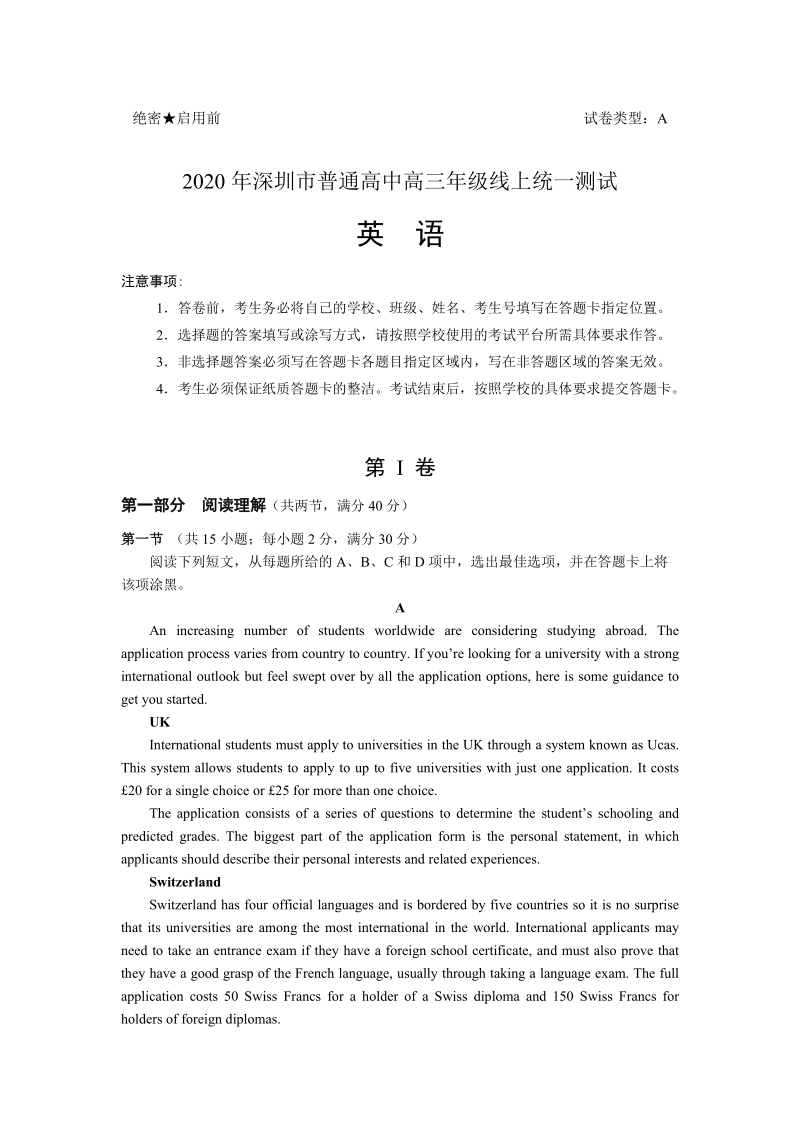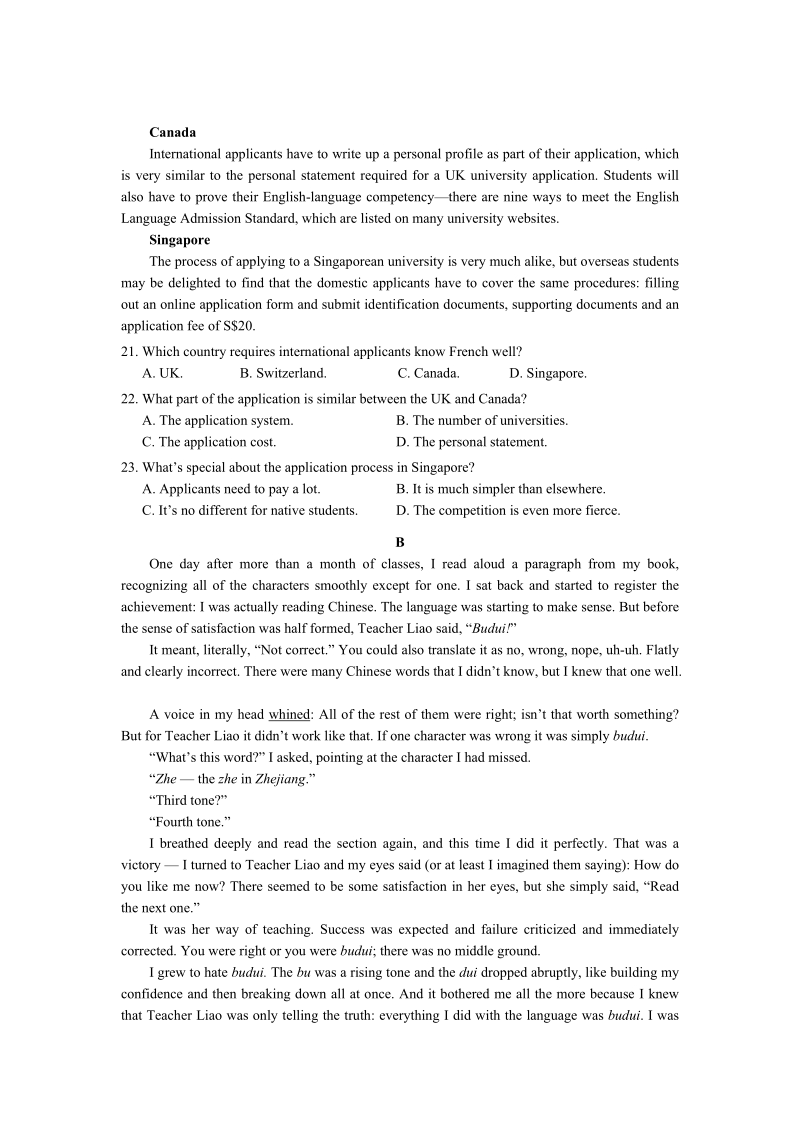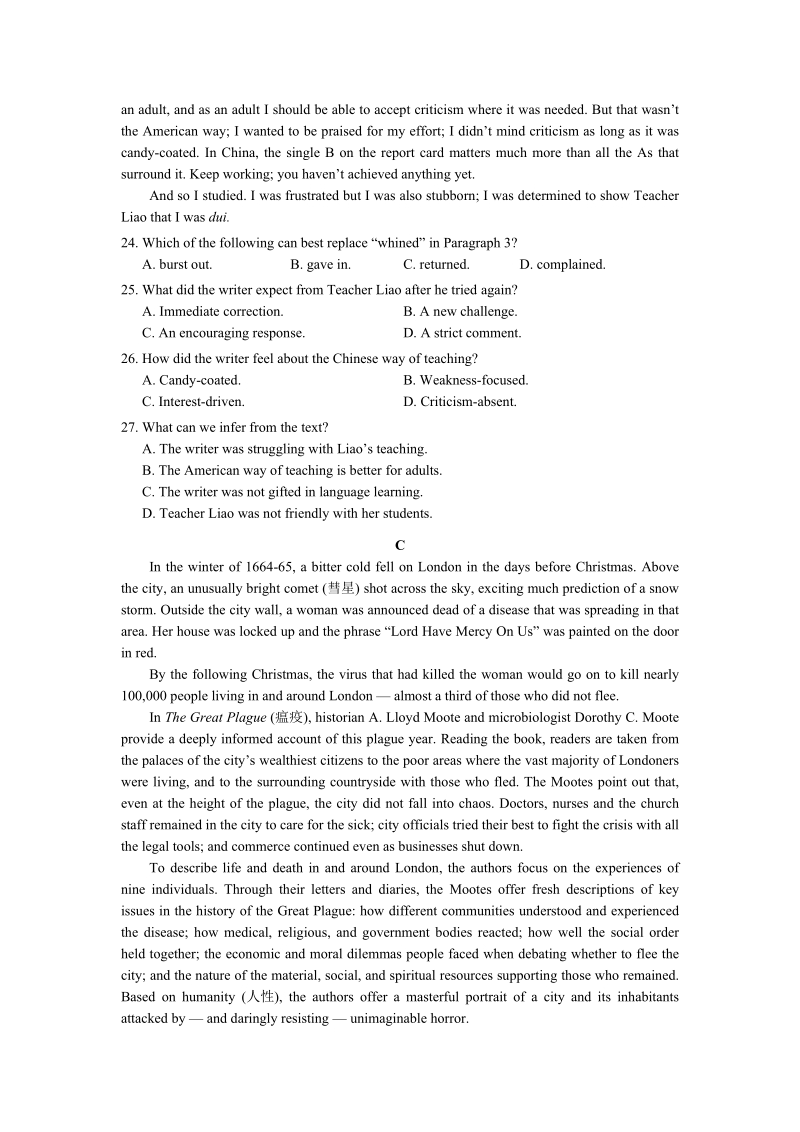 2020年广东省深圳市普通高中高三年级线上统一测试英语试题(含答案)
2020年广东省深圳市普通高中高三年级线上统一测试英语试题(含答案)
《2020年广东省深圳市普通高中高三年级线上统一测试英语试题(含答案)》由会员分享,可在线阅读,更多相关《2020年广东省深圳市普通高中高三年级线上统一测试英语试题(含答案)(10页珍藏版)》请在七七文库上搜索。
1、绝密启用前 试卷类型:A2020年深圳市普通高中高三年级线上统一测试英 语注意事项: 1答卷前,考生务必将自己的学校、班级、姓名、考生号填写在答题卡指定位置。2选择题的答案填写或涂写方式,请按照学校使用的考试平台所需具体要求作答。3非选择题答案必须写在答题卡各题目指定区域内,写在非答题区域的答案无效。4考生必须保证纸质答题卡的整洁。考试结束后,按照学校的具体要求提交答题卡。第 I 卷第一部分 阅读理解(共两节,满分40分)第一节 (共15小题;每小题2分,满分30分)阅读下列短文,从每题所给的A、B、C和D项中,选出最佳选项,并在答题卡上将该项涂黑。AAn increasing number
2、of students worldwide are considering studying abroad. The application process varies from country to country. If youre looking for a university with a strong international outlook but feel swept over by all the application options, here is some guidance to get you started.UKInternational students m
3、ust apply to universities in the UK through a system known as Ucas. This system allows students to apply to up to five universities with just one application. It costs 20 for a single choice or 25 for more than one choice.The application consists of a series of questions to determine the students sc
4、hooling and predicted grades. The biggest part of the application form is the personal statement, in which applicants should describe their personal interests and related experiences. SwitzerlandSwitzerland has four official languages and is bordered by five countries so it is no surprise that its u
5、niversities are among the most international in the world. International applicants may need to take an entrance exam if they have a foreign school certificate, and must also prove that they have a good grasp of the French language, usually through taking a language exam. The full application costs
6、50 Swiss Francs for a holder of a Swiss diploma and 150 Swiss Francs for holders of foreign diplomas. CanadaInternational applicants have to write up a personal profile as part of their application, which is very similar to the personal statement required for a UK university application. Students wi
7、ll also have to prove their English-language competencythere are nine ways to meet the English Language Admission Standard, which are listed on many university websites. SingaporeThe process of applying to a Singaporean university is very much alike, but overseas students may be delighted to find th
8、at the domestic applicants have to cover the same procedures: filling out an online application form and submit identification documents, supporting documents and an application fee of S$20.21. Which country requires international applicants know French well? A. UK. B. Switzerland. C. Canada. D. Sin
9、gapore. 22. What part of the application is similar between the UK and Canada? A. The application system. B. The number of universities.C. The application cost. D. The personal statement.23. Whats special about the application process in Singapore?A. Applicants need to pay a lot. B. It is much simpl
10、er than elsewhere. C. Its no different for native students. D. The competition is even more fierce. BOne day after more than a month of classes, I read aloud a paragraph from my book, recognizing all of the characters smoothly except for one. I sat back and started to register the achievement: I was
11、 actually reading Chinese. The language was starting to make sense. But before the sense of satisfaction was half formed, Teacher Liao said, “Budui!”It meant, literally, “Not correct.” You could also translate it as no, wrong, nope, uh-uh. Flatly and clearly incorrect. There were many Chinese words
12、that I didnt know, but I knew that one well. A voice in my head whined: All of the rest of them were right; isnt that worth something? But for Teacher Liao it didnt work like that. If one character was wrong it was simply budui.“Whats this word?” I asked, pointing at the character I had missed.“Zhe
13、the zhe in Zhejiang.”“Third tone?”“Fourth tone.”I breathed deeply and read the section again, and this time I did it perfectly. That was a victory I turned to Teacher Liao and my eyes said (or at least I imagined them saying): How do you like me now? There seemed to be some satisfaction in her eyes,
14、 but she simply said, “Read the next one.” It was her way of teaching. Success was expected and failure criticized and immediately corrected. You were right or you were budui; there was no middle ground. I grew to hate budui. The bu was a rising tone and the dui dropped abruptly, like building my co
15、nfidence and then breaking down all at once. And it bothered me all the more because I knew that Teacher Liao was only telling the truth: everything I did with the language was budui. I was an adult, and as an adult I should be able to accept criticism where it was needed. But that wasnt the America
16、n way; I wanted to be praised for my effort; I didnt mind criticism as long as it was candy-coated. In China, the single B on the report card matters much more than all the As that surround it. Keep working; you havent achieved anything yet. And so I studied. I was frustrated but I was also stubborn
17、; I was determined to show Teacher Liao that I was dui. 24. Which of the following can best replace “whined” in Paragraph 3? A. burst out. B. gave in. C. returned. D. complained. 25. What did the writer expect from Teacher Liao after he tried again? A. Immediate correction. B. A new challenge. C. An
18、 encouraging response. D. A strict comment.26. How did the writer feel about the Chinese way of teaching? A. Candy-coated. B. Weakness-focused. C. Interest-driven. D. Criticism-absent.27. What can we infer from the text? A. The writer was struggling with Liaos teaching. B. The American way of teachi
19、ng is better for adults. C. The writer was not gifted in language learning. D. Teacher Liao was not friendly with her students.CIn the winter of 1664-65, a bitter cold fell on London in the days before Christmas. Above the city, an unusually bright comet (彗星) shot across the sky, exciting much predi
20、ction of a snow storm. Outside the city wall, a woman was announced dead of a disease that was spreading in that area. Her house was locked up and the phrase “Lord Have Mercy On Us” was painted on the door in red. By the following Christmas, the virus that had killed the woman would go on to kill ne
21、arly 100,000 people living in and around London almost a third of those who did not flee. In The Great Plague (瘟疫), historian A. Lloyd Moote and microbiologist Dorothy C. Moote provide a deeply informed account of this plague year. Reading the book, readers are taken from the palaces of the citys we
22、althiest citizens to the poor areas where the vast majority of Londoners were living, and to the surrounding countryside with those who fled. The Mootes point out that, even at the height of the plague, the city did not fall into chaos. Doctors, nurses and the church staff remained in the city to ca
23、re for the sick; city officials tried their best to fight the crisis with all the legal tools; and commerce continued even as businesses shut down. To describe life and death in and around London, the authors focus on the experiences of nine individuals. Through their letters and diaries, the Mootes



- 配套讲稿:
如PPT文件的首页显示word图标,表示该PPT已包含配套word讲稿。双击word图标可打开word文档。
- 特殊限制:
部分文档作品中含有的国旗、国徽等图片,仅作为作品整体效果示例展示,禁止商用。设计者仅对作品中独创性部分享有著作权。
- 关 键 词:
- 2020 广东省 深圳市 普通高中 三年级 线上 统一 测试 英语试题 答案
 七七文库所有资源均是用户自行上传分享,仅供网友学习交流,未经上传用户书面授权,请勿作他用。
七七文库所有资源均是用户自行上传分享,仅供网友学习交流,未经上传用户书面授权,请勿作他用。



 浙公网安备33030202001339号
浙公网安备33030202001339号
链接地址:https://www.77wenku.com/p-126656.html